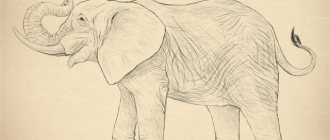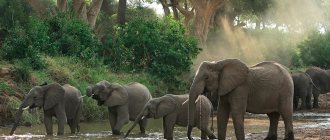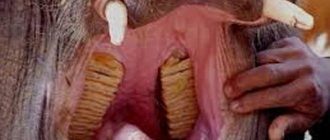If we had not been familiar with elephants from early childhood, perhaps we would have mistaken these giant animals for fantastic creatures. Do you know any other mammals that can eat food with their noses, uproot trees, and even lift people into the air? And the additional fact that elephants renew their molars several times during their lives would raise doubts and surprise.
Today it can be argued that much of what was written in old books about elephants or that has come down to us in ancient legends is at odds with reality. Of course, these animals never lived to be two hundred years old, never fought dragons. But, being mammals that have had a connection with humans since ancient times and are uniquely adapted to living conditions, elephants are extremely interesting. For example, many people want to know what these giants eat, and are amazed that such huge animals are true vegetarians. In this article we will tell you in detail about what elephants eat, in what quantities they consume food and how they get it.
Diet
Everyone knows that currently there are two types of elephants - Indian and African. They are so different from each other that they can be considered representatives of different genera. So the diet of animals directly depends on the region where they live. For example, elephants living in southern India like to chew ficus leaves, while those living in Zimbabwe prefer to consume grasses like cattails and papyrus. What elephants eat also depends on the season: during rains and droughts, the diet will be different.
Where does the African elephant live?
Photo: Large African elephant
African elephant populations used to be much larger. Accordingly, their habitat was much larger and wider. With the increase in the number of poachers, as well as the development of new lands by humans and the destruction of their natural habitat, their range has decreased significantly. Today, the vast majority of African elephants live in national parks and reserves.
Geographical regions of African elephants:
- Kenya;
- Tanzania;
- Congo;
- Namibia;
- Senegal;
- Zimbabwe.
African elephants choose forests, forest-steppes, foothills of mountains, swampy rivers, and savannas as their habitat. For elephants, it is necessary that in their habitat there is a pond, an area with forest as shelter from the scorching African sun. The main habitat of the African elephant is the territory south of the Sahara Desert.
Previously, representatives of the proboscis family lived on a vast territory with an area of 30 million square kilometers. Today it has decreased to 5.5 million square meters. It is unusual for African elephants to live in one territory all their lives. They can migrate long distances in search of food or to escape extreme heat.
Food in captivity
What do elephants eat at the zoo? Here they receive huge quantities of greens and hay. The daily diet also includes root vegetables, a few stale rolls, carrots, heads of cabbage, and apples. Elephants' favorite treat is, of course, bananas. Cookies and bread are also popular. And how proboscideans love candy! No less than people. And just like a person, an elephant runs the risk of overeating sweets and becoming fat, which results in health problems. The animal's behavior becomes unnatural: it walks, staggering, along the fence and just waits for the next visitors to bring the long-awaited delicacy.
Elephants living in the wild move a lot. In search of the amount of food that is enough for their well-being, mammals travel considerable distances every day. In a zoo, animals do not have the opportunity to move as actively, and as a result, they develop digestive problems. The elephants are fed five to six times a day, sometimes fruits and vegetables are cut and mixed with hay and scattered around the enclosure. This is done in order to keep the proboscis busy searching for tasty pieces and thus, firstly, reduce the rate of food absorption, and secondly, entertain.
Natural enemies of African elephants
Photo: African elephant from the Red Book
When living in natural conditions, elephants have practically no enemies among representatives of the animal world. Strength, power, as well as enormous size leave no opportunity even for strong and fast predators to hunt it. Only weakened individuals or small elephant calves can become prey for predatory animals. Such individuals can become prey for cheetahs, lions, and leopards.
Today, the only and very dangerous enemy remains man. Elephants have always attracted poachers, who kill them for their tusks. Elephant tusks are of particular value. They have been highly valued at all times. Valuable souvenirs, jewelry, decorative elements, etc. are made from them.
A significant reduction in habitat is associated with the development of ever new territories. Africa's population is constantly growing. As it grows, more and more land is required for housing and agriculture. In this regard, the territory of their natural habitat is destroyed and rapidly declining.
How much does an elephant eat per day
Every day an adult animal consumes approximately 250 kilograms of food and 100-150 liters of liquid. For clarity, we will tell you what elephants eat at the Moscow Zoo. A large proportion of their daily diet consists of tree branches collected in brooms. Willow branches are most often used, and per day one elephant absorbs an average of forty willow brooms (about six to eight kilograms). Every day, proboscideans are also given thirty kilograms of grass and hay, and several kilos of straw as a supplement. The grain part of the menu consists of oats (one to two kilograms), oatmeal (four to five kilograms), bran (one kilogram), bread (several kilograms). Of the succulent food, the elephants are given fruits: pears, apples, bananas (eight kilograms). And vegetables: carrots (fifteen kilograms), cabbage (three kilograms), beets (four to five kilograms). In summer, watermelons are included on the menu. It is noteworthy that mammals do not eat cabbage and watermelons whole, but first place them on the floor and lightly crush them with their feet. Animals also consume potatoes, but only boiled, and sometimes they are even given a little onion. This is, perhaps, the entire list of what elephants eat in a zoo.
Tips for proper eating of elephants
To destroy an elephant cheerfully and quickly, you must:
- Divide it into precisely measured steaks. A goal tree is ideal for this.
- Allocate resources to solve all problems. We recall the ideas of the SMART methodology and implement them.
- Decide on a time frame. You can measure the time for the whole carcass, you can set your own deadlines for each piece.
- Do at least something every day. This is a very important point, so it can be inserted throughout the rules and recommendations regarding eating elephants.
- Reward yourself when the elephant runs out! And praise! Any pleasant thing can be a reward: even a trip to a cafe, even a favorite book.
Actually, this is where you can stop giving advice on how to eat an elephant - achieve your goals, and start asking.
What elephants did you have or do you have? What did they do with them, and did they manage to eat the entire huge carcass without violence?
Interesting articles:
Features of nutrition in the wild
Males consume up to 170 kilograms of fresh plants per day, while females are content with approximately 150 kilograms. Typically, proboscideans prefer vegetation that is located at a height of no more than two meters. The elephant will stretch its trunk higher only if the delicacy is really worth it; if necessary, it can stand up on its hind legs. Often young males will cut down small trees just for fun.
As we have already said, what elephants eat in Africa and what they eat in India differs significantly. For example, among savannah proboscideans from Uganda, up to 88 percent of the daily diet is grass, and Indian mammals consume mainly leaves, although they are also not averse to pampering themselves with tasty tubers and roots. As a rule, the elephant uproots the plant, shakes off the soil on its leg or tusk and puts the delicacy into its mouth.
Reproduction and offspring
The mating process of elephants does not have any seasonal restrictions, so females mate with males when they are ready for this process. As a rule, during periods of readiness to mate, males are capable of unmotivated aggression. Their glands, located in the ear area, secrete a special secretion that spreads in the air for many kilometers, signaling their readiness to mate. This condition of elephants in India is called must.
Important point! In this state, males are the most aggressive. Therefore, they can attack people.
When the females are ready to mate, they move away from their group and begin to make loud sounds that can be heard for many kilometers around. The males, hearing the calling roar of the females, head to her location, where they begin to fight for the right to fertilize the female. Such fights do not pose any threat to the life of the males, since they compete to appear larger by spreading their ears and making loud noises. Therefore, the challenger is larger and louder. If they fail to identify a larger and louder male, they begin to cut down trees and lift their trunks. Showing off your strength. The strongest can drive away other contenders for many kilometers.
After mating, females carry their future offspring for an average of 20 weeks. The offspring are born in the company of other, more experienced females, who are always ready to help and protect from natural enemies. Mostly one baby elephant is born, but there are cases of twins being born. The weight of a newborn is comparable to that of an adult. Within a couple of hours after birth, the baby gets to his feet and begins to drink mother's milk. After birth, the whole family makes loud noises, welcoming it and announcing to the whole world about the addition of the family.
Interesting to know! Elephants have nipples on their front legs, like primates, and not in the groin of their hind legs, like most mammals.
Elephant calves feed on their mother's milk for two years, while a calf can feed from any female who is nursing her growing offspring. Despite this, after only six months of life, baby elephants begin to get used to plant foods.
Elephants are looked after by the entire family until the age of five, and family affection remains for life. After this, the males are expelled from the herd, and the females remain to make up for the natural losses of the family. Around 10 years old, elephants become sexually mature.
Food absorption process
We have already talked about what elephants eat, now I would like to talk about how they do it. Animals grind hard food with only four teeth. In proboscideans, the hard enamel ridges on the teeth are arranged transversely, so they move the lower jaw back and forth, and not from side to side, like, for example, cows. Elephants chew plant parts or wood quite thoroughly in order to absorb nutrients with maximum benefit. The animals' intestines are approximately 35 meters long, which is much shorter than those of cattle. Therefore, proboscideans assimilate any food unimportantly, and even less so wood. About half of what you eat per day remains undigested.
What do elephants eat when food is scarce? They strip trees, absorbing bark, causing great damage and making it impossible for humans to restore the forest in these places. But nothing can be done, the animals simply have no choice, and if they spare the trees, they will die themselves. But thanks to what the African elephant eats, or rather, how it does it, it is possible to preserve and distribute many plant species. The fact is that savannah proboscideans transfer the seeds they eat to places with a good amount of light, where they receive excellent conditions for germination. Experts have calculated that if not for elephants, 36 plant species would have disappeared in Africa.
Links[edit]
- BBC News. 2006. Early signs of elephant butchers. Downloaded July 2, 2006 from https://news.bbc.co.uk/2/hi/science/nature/5128892.stm.
- ^ a b c
"Elephants in Central Africa are killed for meat - World News - World Environment".
NBC News
. 2007-06-06. Retrieved July 8, 2014. - "Conserving African Elephants". . Retrieved January 10, 2021.
- "News - Sale of elephant meat increases danger to elephants in Central Africa". . 2012-03-08. Retrieved July 8, 2014.
- "New Taste of Thai Elephant Meat". . 2011-10-31. Retrieved July 8, 2014.
- “Elephant meat is a commodity for poachers.” Fox News. 2007-06-07. Retrieved July 8, 2014.
- https:///downloads/ssc_op_045.pdf
- … Mahavga (Mv.VI.23.9-15) prohibits ten types of flesh: human, elephants, horses, dogs, snakes, lions, tigers, leopards, bears and hyenas…
- Mufti Faraz Adam (6 May 2012). “Is it permissible to eat elephant meat? Publisher = Darul Fiqh".
- Mufti Muhammad ibn Adam (April 20, 2005). "Why can't I eat elephant?" . Leicester, UK: Darul Iftaa.
Fluid requirement
Proboscideans drink a lot (as already noted, up to 150 liters daily). If during a drought all available sources of water dry up, animals go in search of life-giving moisture. Using their trunks and tusks, they dig holes up to a meter deep in dry river beds, into which groundwater slowly flows. Other inhabitants of the savannah, unable to obtain drink in this way, patiently wait until the elephants quench their thirst, and then drink plenty themselves. Thus, proboscideans help them survive drought. However, it also happens that efforts to find water do not bring the desired result, and then hundreds, or even thousands of animals die from dehydration.
How to cook an elephant?
It is not customary to fry elephant meat. During this processing, the meat becomes tough, and tasters do not like the unusual taste.
The fattest pieces are removed from the area around the giant's eyes. Only the most tender parts of the carcass are used for steaks: the legs. The tip of the trunk is also valuable, and is credited with the properties of a powerful aphrodisiac. The remaining parts of the carcass are preserved.
Usually the meat is baked in a fairly large pit filled with brushwood and firewood. When it all burns down, the limbs and trunk are placed in the ashes. Coals are poured on top and the fire is rekindled, which is then maintained for about seven hours. The crust is removed from the finished legs, and spices and other ingredients are added to the baked meat. To make the meat juicy, a metal canopy is fixed over the pit; it prevents the heat from escaping.
Dried and then powdered strips of meat are used to prepare Thai sauces. You can make dumplings from the offal. The peel, chopped with a knife, is dried like mushrooms, and then used as a seasoning for first courses.
In pursuit of food
Few people know that elephants eat for 17-19 hours a day. This is how long it takes them to satisfy their need for food. In the tropics, where the days are shorter than ours, proboscideans even have to spend several hours at night to get adequate nutrition. Animals wait out the heat of the day in water or in the shade so as not to overheat, and therefore lose precious time that they could spend on eating. During drought, elephants have to cross long distances every day between watering holes and pastures; they constantly move around the territory.
Time management: types of “elephants”
Sometimes it is not clear at first which elephants need to be gradually eaten. Let's try to figure it out.
These could be things or goals of the following nature:
- losing weight by a fairly large amount;
- working on a serious analytical report;
- studying of foreign language;
- preparing a trip or moving;
- admission to the University;
- preparation for competitions;
- opening an enterprise;
- website promotion.
All these are examples of typical elephants, since the goals of such a plan are not achieved in one action, but require systematic work. To understand the number of steps required to solve a problem, you can use a “goal tree”. Simple, visual and perfect for dividing elephants into pieces.
Pinnawela - elephant shelter
The Pinnawela Elephant Nursery is located 45 km from the major tourist city of Kandy. And 100 km from the actual capital of the island - Colombo. Thanks to this location, the shelter is wildly popular among tourists and local residents.
Typically, guests to Ceylon plan a route along the way to get acquainted with the city of Kandy, see the Temple of the Tooth Relic, visit the spice garden and the royal botanical garden in Peradeniya, the Alagalla mountain range. And with it, the Pinnawela Elephant Orphanage.
As mentioned above, the initial purpose of the orphanage was to preserve disabled elephants (victims during the civil war) and baby elephants who were orphaned. Since the opening of the shelter (1975), more than 20 elephants have been born here.
Gradually, Pinnawela began to look more like a tourist attraction than a cozy haven for savannah giants. The shelter offers:
- Elephant riding.
- Feeding animals.
- Swimming in the river.
The main feature of Pinnawela is watching a herd of elephants, which are led to swim through the entire city to a pond.
Pinnawela Elephant Nursery on the map
Ticket price and opening hours
You can visit the nursery from 8-30 to 18.00.
Price: about 2500 rupees per adult. And 1000 rupees per child.
The most convenient way to watch swimming is from the site of the Elephant Bay Hotel.
How to get there
The closest major cities to Pinnawala are Colombo and Kandy. Trains and buses go in this direction.
How to get to Kandy - read the detailed route.
From Kandy you can get to the shelter by taxi or tuk-tuk. Rambukkana is the nearest railway station to Pinnawala.
Elephant bathing: schedule
- Morning: 9-00 feeding. An hour later, at 10-00, swimming.
- Evening: 13-00 feeding. An hour later, at 14-00, swimming.
Boon Lott's Elephant Sanctuary
Like ENP, "there are no shows at Boon Lott's - just elephants." Simple guest houses allow a small number of visitors to stay overnight in the reserve. Book your spot in advance to “experience all aspects of the elephant world at BLES.
This is a hands-on experience that involves foraging and walking with animals. There are also ample opportunities for elephant viewing in the local environment.” Although they offer transfers directly from Sukhothai Airport, you can extend your stay in the area to explore the ancient temples of Sukhothai.
We wish you good luck in your research and decision making - there is quite a lot of information after all!
Why are elephants afraid of mice?
It would seem an amazing paradox of nature, a mighty giant elephant is afraid of a small mouse. In fact, no, since the elephant’s fear of mice, which has become a “talk of the town,” is in reality nothing more than a myth, a legend, since elephants are not afraid of mice, zoo workers know this well, the elephants there are completely indifferent to small rodents and are not They pay no attention to them.
But where do the roots of this funny legend come from? There is a version that elephants are afraid of mice, because in the old days there were so many mice that they dared to attack elephants’ legs, and even managed to gnaw the elephants’ limbs to the bone. But this is just an explanation of a legend that has no basis in reality
Why does an elephant need a trunk?
Among the ancient ancestors of the elephant, who were semi-aquatic animals, the trunk was used exclusively for breathing when immersed under water. Subsequently, it stretched out, the structure was supplemented by numerous groups of circular and longitudinal muscles, and a finger-like process formed at the end. All this significantly expanded the functionality of the trunk. With its help, the animal reaches tree branches and plucks grass. During a watering session, the elephant takes 6-7 liters of water inside and then pours it into its mouth. Using its trunk, the elephant trumpets - produces a characteristic roar, using its elongated nose as a wind instrument. When moving a herd over long distances, the babies usually follow the females and at the same time hold onto their tail with their trunks.
Gon
This is a unique condition of elephants that has not yet been scientifically explained. It affects sexually mature males aged 20 to 50 years, occurs annually and lasts from 2 to 3 weeks, usually during hot weather. The elephant becomes agitated, aggressive and dangerous. Even placid animals have been known to kill humans and other elephants when they are in the rut.
The reasons are not clear. The animal is sexually excited, but this is not completely sexual behavior. Elephants mate outside of the rutting season, which is not the same as the mating season of other mammals.
The rut begins with a strong smelling oily secretion flowing from the gland above the eye. This secretion escapes from the elephant's head and enters the mouth. The taste of the secretion drives the animal crazy. Domesticated elephants undergoing the rut are kept chained and fed at a distance until the condition subsides and the animal returns to normal. At the age of 45-50 years, the rut gradually subsides, eventually disappearing completely. In exceptional cases, females exhibit this condition.
Social behavior of elephants
Elephants are socialized animals and live in family groups. Herds consist of females and their young, led by the female, who is the undisputed leader; wherever she goes, the herd always follows her.
At the beginning of maturation, young males are driven out of the herd, and they form small groups of up to 10 animals, which move at a distance behind the main female group. When males reach 25 years of age, they form pairs or triplets.
There is a hierarchy among adult males, with the dominant elephant having mating rights. This privilege is won through battles against other elephants. Herds, including male groups, gather near water bodies or in grazing areas. There is no friction between the groups and the elephants seem to enjoy the encounters.
Man and elephants
Elephants are such unique living beings that humans cannot take advantage of them, both in the good and bad sense of the word. Despite security measures, elephant ivory has not lost its value even today, so poachers take advantage of this and do not stop hunting elephants.
In many Asian countries, as well as in India, elephants are used as a powerful labor force, and often young elephants are removed from their natural habitat without thinking about the consequences.
Secrets of the life of elephants (documentary film)
Why does an elephant have a long nose?
The long elephant trunk, also known as the nose, has also become food for many myths and legends. For example, one instructive African tale tells us about a curious little elephant who, wanting to find out who lives in the swamp, fell into the mouth of a crocodile. The crocodile grabbed the baby elephant by its nose, wanting to drag it under the water, but the baby elephant resisted with all its might and eventually escaped from the crocodile’s mouth, only after that its nose became long, long and turned into a trunk. And since then, they say, all elephants have long trunks as a result of the curiosity of that little elephant who stuck his nose where it shouldn’t.
In fact, the trunk of elephants was formed gradually as a result of millions of years of evolution. And what’s interesting is that young elephants spend several months learning the art of controlling their trunks.











